

EXPLORE BY TOPIC:
  Our top 10 resources
Our top 10 resources
  Childhood / Early Life
Childhood / Early Life
  Chronic Stress
Chronic Stress
  Education
Education
  Food Security
Food Security
  Genetics
Genetics
  Jobs & Work
Jobs & Work
  Housing / Neighborhoods
Housing / Neighborhoods
  Income & Wealth
Income & Wealth
  Race / Racism
Race / Racism
  Social Inclusion
Social Inclusion
  Policy & Change
Policy & Change





Buy the DVD
e-Newsletter
FAQs
Contact Us
Site Map
Home

|
 |


|
Background: Perhaps the biggest predictor of one's health is one's wealth. It's not just the poor who are suffering; every step down the class pyramid corresponds to worse health. Study after study has shown that those at the top of the class pyramid live on average longer, healthier lives than the rest of us. The middle classes fare worse than those on the top, and the poor get sick more often and die sooner.
The greater the inequality in a society, the steeper the gradient. Currently, the United States has the greatest inequality among rich countries - and the worst health inequities. People in the middle are twice as likely to die prematurely (before age 65) as those on top; people at the bottom are three times as likely.
The life expectancy of American men in the highest income group is 8 years longer than for men in the lowest income group, two and a half years longer than for the second highest income group. Wealthy women live almost 7 years longer than poor women. Children in low-income families are seven times as likely to be in poor or fair health as those in high-income families. Poorer adults are three times as likely to have a chronic disease that limits their activity; twice as likely to have diabetes, and are nearly 50% as likely to die of heart disease.
Wealth doesn't just bring more material comfort, it also provides financial security and access to resources that promote opportunities for better health. Higher income affects health at every age, from the beginning of life to adulthood and old age. For adults, wealth is tied to neighborhood quality, work conditions, food security, access to medical care, and the availability of buffers against stress.
For children, the impact of advantages or disadvantages is even greater, because the effect on health is cumulative. The greater proportion of life one spends at the upper end of the class spectrum, the more benefits accrue. Children from affluent families are more likely to grow up in a house owned by their parents and to live in a neighborhood with healthy food options, safe places to play, good schools, libraries and other quality public services – all of which help set them on the path to a successful, healthy life.
Children from less affluent families not only lack these advantages, they are more likely to experience conditions that limit their health and ultimately their life chances: injuries, inadequate or delayed health care, physical inactivity, poor nutrition, insecure or substandard housing, and exposure to toxins, high lead levels and violence. The influence of wealth on health begins even before a child is born, shaping the quality of prenatal care an expectant woman receives, her level of stress during pregnancy and her likelihood of delivering a premature or low birth weight baby.
Wealth is an important determinant of health because it has such a profound effect on other conditions. Yet at every socioeconomic level, African Americans, Native Americans and other people of color fare worse than their white counterparts. Racism as a stress factor independent of class partially explains this, but racism – for example, in the form of residential segregation or job discrimination – also directly affects wealth.
Today, the wealth gap in America is growing. The average CEO makes more than 250 times the average worker’s salary, and the top 1% of American households holds more wealth than the bottom 90% combined. In the last 25 years, the income of top earners has increased 81%, while wages for those on the low end of the pay scale have stagnated or declined.
Our health has followed suit. In 1980, the U.S. ranked 14th in the world for life expectancy. In 2007 we ranked 29th. One out of every five American children lives in poverty. Many of the countries that rank higher than we do have policies that protect workers, support families, and provide a safety net for their citizens. These policies typically address income and wealth inequality in one of two ways: (1) they reduce the overall gap so that everyone has sufficient resources to prosper and maintain control over their lives or (2) they loosen the connection between health and wealth by making certain resources available to everyone, not dependent on a family's individual assets.
Examples of policies to reduce the gap include a guaranteed living wage, earned income tax credits, family supports, guaranteed paid vacation and sick leave, secure pensions, and severance pay and job training for unemployed workers. Examples of policies to loosen the wealth-health relationship include universal preschool, better land use and zoning policies, school financing reform, universal health insurance, and stronger environmental protections and better enforcement.

|
|
|
| |
|
Income & Wealth: 0 items found |
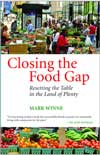 The Poor Get Diabetes, the Rich Get Local and Organic The Poor Get Diabetes, the Rich Get Local and Organic 
ARTICLE by Mark Winne In this excerpt from his new book, Closing the Food Gap: Resetting the Table in the Land of Plenty, Mark Winne explains a growing split in the diets of the haves and have-nots; at the same time that the wealthy are coming to prefer organic and locally-grown foods, the poor have been losing geographical and economic access to healthy options. He also reports on a survey by the non-profit group Hartford Food System, which found that low-income consumers in the area would prefer to purchase organics and fresh foods, but simply couldn't access or afford them. |
 |
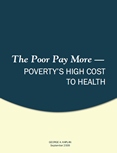 The Poor Pay More: Poverty's High Cost to Health The Poor Pay More: Poverty's High Cost to Health 
This report describes many of the ways in which being poor is bad for one’s health and points to policies that have the potential for restoring the prospect of good health to the lives of the poor. We present compelling evidence that poverty has an impact on not just the body politic but the body corporeal as well— that being poor leaves a broad footprint on the health of individuals. The health costs of poverty are high. Those among us who are poor tend to have
more illness and die younger. The report begins with descriptions of key determinants of health and the impact they have been shown to have on health. It then offers several policy options that might ease poverty and thereby improve health. |
 |
 The Praxis Project The Praxis Project 
WEB SITE The Praxis Project is a national, nonprofit organization that builds partnerships with local groups to influence policymaking to address the underlying, systemic causes of community problems. Committed to closing the health gap facing communities of color, they forge alliances for building healthy communities. Praxis trains its partner organizations and provides research, technical assistance and financial support to tackle issues impacting the well being of communities. Their site contains an information resource center with additional resources and reports on equity and social justice. |
 |
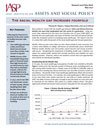 The Racial Wealth Gap Increases Four-Fold The Racial Wealth Gap Increases Four-Fold 
Thomas M. Shapiro, Tatjana Meschede,and Laura Sullivan Assessing the wealth holdings of the same families for 23 years (1984-2007) shows that the wealth gap between whites and African Americans increased more than 4 times, from $20,000 in 1984 to $95,000 in 2003. This gap persisted for African Americans and white families in the same income range. For example, middle-income white households had greater gains in financial assets than high-income African Americans; by 2007, they had accumulated $74,000, whereas the average high-income African American family owned only $18,000. At least 25% of all African American families had no assets to turn to in times of economic hardship. |
 |
 The Spirit Level slides The Spirit Level slides 
GRAPHS from The Equality Trust This PowerPoint file contains 36 of the more important graphs from the Equity Trust web site and/or published in The Spirit Level, illustrating the relationship between levels of economic inequality within countries and health and social problems. They can be downloaded and used in presentations as long as you acknowledge The Equality Trust as their source. |
 |
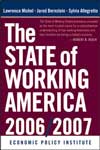 The State of Working America 2006/2007 The State of Working America 2006/2007 
REPORT by Mishel, Bernstein, and Allegretto, Cornell University Press and the Economic Policy Institute, 2007 Prepared biennially since 1988, EPI's flagship publication sums up the problems and challenges facing American working families, presenting a wide variety of data on family incomes, taxes, wages, unemployment, wealth, and poverty — data that enables the book's authors to closely examine the impact of the economy on the living standards of the American people. The State of Working America 2006/2007 is an exhaustive reference work that will be welcomed by anyone eager for a comprehensive portrait of the economic well-being of the nation. |
 |
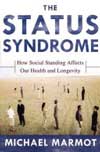 The Status Syndrome: How Social Standing Affects Our Health and Longevity The Status Syndrome: How Social Standing Affects Our Health and Longevity 
BOOK by Sir Michael Marmot, 2004 Marmot, advisor to the World Health Organization and one of the premiere scholars on social determinant of health, presents the results of his own 30 year study into the effects of class on health, together with a comprehensive overview of current theory and research. He highlights how a sense of autonomy and control over our lives can be a key factor in our ability to live long, thriving lives. |
 |
 The Story of Stuff The Story of Stuff 
VIDEO and WEBSITE by Annie Leonard This entertaining and often surprising 20 minute video explains in easy language how "stuff" is produced, distributed, sold, and disposed of - and why the current system is in crisis. The Web site then offers tips for what you can do to help change the destructive chain, and inspiration for how to get involved in a wide variety of possible ways. |
 |
 The Wealth Factor The Wealth Factor 
ARTICLE by Dalton Conley, New York University What difference does wealth make in terms of your life opportunities? Over recent years, magazines and newspapers have run a variety of articles that explore why middle-class Black children don't do as well in school as white children from families with similar socio-economic backgrounds. These "achievement gap" articles are based on studies that relate achievement to family incomes. But the findings from these studies, argues one researcher, are highly misleading--because they simply fail to factor in what may be the key determinant to socio-economic status: family wealth. |
 |
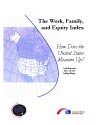 The Work, Family, and Equity Index: How Does the United States Measure Up? The Work, Family, and Equity Index: How Does the United States Measure Up? 
REPORT by The Project on Global Working Families, 2007 The Work, Family, and Equity Index has been developed to measure governmental performance around the world in meeting the needs of working families in general and and low- and middle-income working families in particular. The policies used to comprise the index have achieved widespread recognition based on the weight of the research evidence or consensus in global policy and international agreements. |
 |
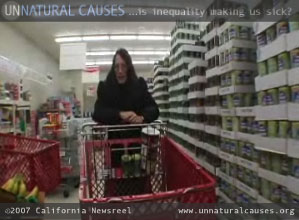 There's No Such Thing as Small Stuff: Being Poor in Louisville There's No Such Thing as Small Stuff: Being Poor in Louisville 
WEB-EXCLUSIVE VIDEO, Unnatural Causes Mary Turner, featured in "In Sickness and In Wealth," lives in a poor neighborhood of Louisville, KY. With three teenage children, a husband on disability, and health complications that prevent her from working, Mary must budget carefully to keep her family fed and housed. In this video, she discusses the choices she faces every day, quickly but eloquently presenting a glimpse of one woman's life at the lower end of the U.S. socio-economic spectrum. |
 |
 Tohono O'odham Community Action (TOCA) Tohono O'odham Community Action (TOCA) 
WEB SITE TOCA is a community- based organization dedicated to creating cultural revitalization, community health and sustainable development on the Tohono O'odham Nation. TOCA was founded in 1996 as a non-profit organization. TOCA has adopted principles that represent our approach to community development and guide our programs. |
 |
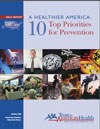 Top Ten Priorities for Prevention Top Ten Priorities for Prevention 
ISSUE REPORT, Trust for America's Health TFAH has identified 10 key policy areas where government action could improve the health of the U.S. population and lower the costs associated with treating people after they're already sick:
- Promoting Disease Prevention
- Combating the Obesity Epidemic
- Preventing Tobacco Use and Exposure
- Preventing and Controlling Infectious Diseases
- Preparing for Potential Health Emergencies and Bioterrorism Attacks
- Recognizing the Relationship Between Health and U.S. Economic Competitiveness
- Safeguarding the Nation's Food Supply
- Planning for Changing Health Care Needs of Seniors
- Improving the Health of Low-Income and Minority Communities
- Reducing Environmental Threats
And a crosscutting recommendation for:
- Holding Government Accountable for Protecting the Health of Americans
|
 |
 Toxic Wastes and Race Revisited (pdf) Toxic Wastes and Race Revisited (pdf) 
REPORT by Benjamin A. Goldman and Laura J. Fitton, 1994 An update on the 1987 report on the racial and socioeconomic characteristics of communities with hazardous waste sites. Co-sponsored by Center for Policy Alternatives, NAACP, and United Church of Christ Commission for Racial Justice |
 |
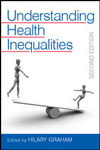 Understanding Health Inequalities Understanding Health Inequalities 
BOOK edited by Hilary Graham, 2nd ed. 2009 An accessible and engaging exploration of why the opportunity to live a long and healthy life remains profoundly unequal. Hilary Graham and her contributors outline the enduring link between people's socioeconomic circumstances and their health and tackle questions at the forefront of research and policy on health inequalities. |
 |
 Unequal America: Causes and Consequences of the Wide- and Growing- Gap Between Rich and Poor Unequal America: Causes and Consequences of the Wide- and Growing- Gap Between Rich and Poor 
Disparities in health tend to fall along income lines everywhere: the poor generally get sicker and die sooner than the rich. But in the United States, the gap between the rich and the poor is far wider than in most other developed democracies, and it is getting wider. That is true both before and after taxes: the United States also does less than most other rich democracies to redistribute income from the rich to the poor.
Americans, on average, have a higher tolerance for income inequality than their European counterparts. American attitudes focus on equality of opportunity, while Europeans tend to see fairness in equal outcomes. Among Americans, differences of opinion about inequality can easily degenerate into partisan disputes over whether poor people deserve help and sympathy or should instead pull themselves up by their bootstraps. The study of inequality attempts to test inequality’s effects on society, and it is delivering findings that command both sides’ attention. |
 |
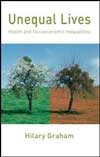 Unequal Lives: Health and Socioeconomic Inequalities Unequal Lives: Health and Socioeconomic Inequalities 
BOOK by Hilary Graham This book introduces the non-specialist to key concepts like health inequalities and health inequities, social class and socioeconomic position, social determinants and life course, as well as to the key indicators of health and socioeconomic position. It brings together research from social epidemiology, sociology and social policy to guide the reader to an understanding of why people's lives and people's health remain so unequal, even in rich societies where there is more than enough for all. |
 |
 United for a Fair Economy United for a Fair Economy 
WEB SITE A national, independent, nonpartisan, non-profit organization, UFE raises awareness that concentrated wealth and power undermine the economy, corrupt democracy, deepen the racial divide, and tear communities apart. We support and help build social movements for greater equality. |
 |
 WakeUpWalMart.com WakeUpWalMart.com 
WEB SITE of "America's Campaign to Change WalMart" Wal-Mart is America's largest employer, yet pays poverty level wages, leaves over 775,000 of its workers without company health care, faces the largest gender discrimination lawsuit in the country, shuts down small businesses and helps ship jobs overseas. This campaign to change Wal-Mart is "a fight for what kind of America we want to live in. In our America, people come first. Multi-billion dollar corporations shouldn't be able to hide behind their special interest lobbyists and billion dollar ad campaigns. That is why we are building the largest grassroots campaign to change a corporation in history. By changing Wal-Mart, we improve people's lives, help our community and build a better America." |
 |
 Waking Up from the American Dream: Meritocracy and Equal Opportunity Are Fading Fast Waking Up from the American Dream: Meritocracy and Equal Opportunity Are Fading Fast 
EDITORIAL by Aaron Bernstein, Business Week Magazine, 2003 Dead-end jobs and the high cost of college could be choking off upward mobility... |
 |
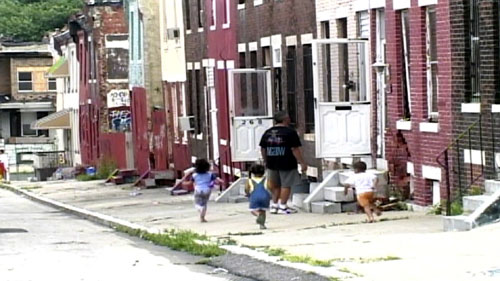 Wealth Equals Health Wealth Equals Health 
VIDEO EXCERPT, Unnatural Causes - Episode 3 Wealth and health are tightly linked in the United States. As immigrants remain in the country, as they "become American," their socioeconomic status becomes increasingly relevant to their health status. For those who experience discrimination, low wages, unstable employment, and other stressors, this relationship may erode the health advantage they enjoyed upon arrival in the country. |
 |
 Whitehall Study of British Civil Servants Whitehall Study of British Civil Servants 
WEB SITE by the University College London Epidemiology and Public Health A source for more information about the Whitehall Study, led by Sir Michael Marmot. This study, described in the series, followed British civil servants for 30 years and provided clear evidence of the health-wealth gradient. |
 |
Why Being a Leader is Less Stressful than Following 
ARTICLE by Maia Szalavitz, TIME Health & Family, September 26, 2012
Research increasingly suggests that it’s actually people lower down on the social scale — not those in leadership positions at the top — who suffer the worst health effects of stress. Now a new study of military officials and government staffers at a Harvard executive-training program confirms these findings, showing that as people climb the organizational rungs, their stress hormone levels and anxiety typically go down.
|
 |
 Why Our Greatest Health Concern Isn't Diet or Exercise - It's Neighborhood Why Our Greatest Health Concern Isn't Diet or Exercise - It's Neighborhood 
OP-ED by Larry Adelman on AlterNet.org, February 19, 2009
Series Creator and Executive Producer Larry Adelman expands upon economist Robert Evan's analogy of health care as a repair shop to illustrate the crucial role that "road conditions" play in determining our health status.
Download as PDF. |
 |
 Working Group on Extreme Inequality Working Group on Extreme Inequality 
WEB SITE Based at the Institute for Policy Studies, the Working Group is a growing coalition of organizations who have learned in their struggles against poverty that the fight against inequality has to both “raise the floor” and challenge the concentrated wealth and power that increasingly sit at the top of our economic ladder. The group's work consists of reaching out to different constituencies, generating educational materials, and promoting public policies to slim grand accumulations of private wealth. |
 |
| « Prev 1 | 2 | 3 | 4 | 5 | 6 | 7 Next » |
|




